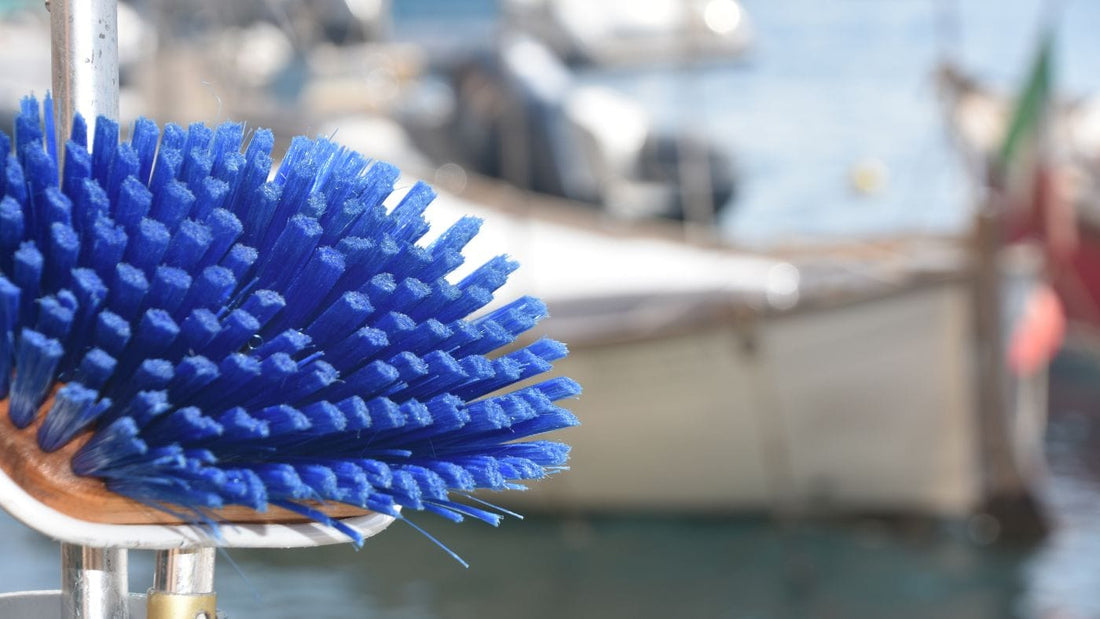
Deck Scrub Brush vs. Microfiber Wash Mitt — Which Should I Use?
Nicholas HeislerShare
From the wood of your deck to the fiberglass of your hull to the upholstery of your seats, boats can harbor dirt, grime, mold, mildew, and even invasive species if they’re not well-kept. As such, it’s not enough to just tidy up a boat; it must be cleaned properly, and that’s why it’s important to have the right tools for the job.
As you gather these tools, one of the most fundamental decisions you’ll have to make is whether to use a scrub brush, a microfiber wash mitt, or even a combination of the two. Let’s compare them to see which you should use and when.
Deck Scrub Brushes
A brush on the end of a pole is a great way to scrub areas that are hard to reach, especially if that pole is extendable.
Benefits:
- Brushes are available in a variety of stiffnesses, from soft to hard, allowing boat owners to clean different parts of their boats without damaging them.
- Brushes are durable and can be thoroughly cleaned to avoid spreading contaminants and dirt.
- A single pole can accommodate many different brush types with varying levels of stiffness or size.
- With long bristles, brushes can swipe away dirt in even the tightest of spaces.
Disadvantages:
- If a user uses the wrong brush stiffness, it will either be ineffective at cleaning or damage the boat surface.
- Brushes can hold onto dirt and grime if not properly cleaned, which can either lead to poor cleaning or scratching of the boat’s finish.
- Brushes can’t easily wrap around cylindrical objects such as poles or pipes.
- Brushes aren’t absorbent in the ways that towels or mitts often are.
Takeaway:
One of the keys to getting great results with brushes is to match them to a given job. A soft brush is appropriate for a boat’s hull since it won’t scratch the hull’s coating or paint, while a hard-bristle brush is perfect for cleaning decks where the surface can handle deep scrubbing to eliminate ground-in dirt. In either case, brushes can last a long time and withstand frequent use, though regular cleaning of the bristles will be necessary to avoid spreading contaminants.
Microfiber Wash Mitts
For a more hands-on approach, microfiber wash mitts fit over the hand and allow users a more tactile cleaning experience.
Benefits:
- When the boat cleaning is done, simply toss the mitt in with your next load of laundry to clean it.
- Wash mitts are gentle on finishes and won’t leave streaks or swirl marks.
- Users won’t need to keep returning to their wash buckets; mitts are incredibly absorbent and hold a lot of soap and water at once.
Disadvantages:
- Once a microfiber mitt gets leaves or pebbles tangled in it, it can be nearly impossible to get clean again and will likely need to be thrown away.
- Wash mitts aren’t nearly as durable as brushes. Even with proper care and washing, the fibers can loosen and fray; additionally, the mitt will slowly absorb dirt and become less able to clean surfaces.
- The user’s reach is limited to the length of their arm.
- A mitt’s fibers can’t get into as many tight crevices as a brush.
- Wash mitts are soft, meaning they’re not as good for deep cleaning of decks as hard-bristle brushes.
Takeaway:
Wash mitts require more care than brushes. If you drop a wash mitt onto a leaf-covered, dirty driveway before making it to your boat, it can become immediately unusable because it will pick up every bit of detritus it touches. Users must also be careful to continually rinse their mitts to ensure they’re not spreading dirt and grime around the surface of their boat. We recommend the use of a dirt trap in your bucket to keep your wash mitts cleaner for longer.
Nevertheless, for cleaning jobs that require a soft touch, a microfiber wash mitt is an excellent tool, especially if the goal is to achieve a mirror-like shine on a boat’s finish.
Which Boat Cleaning Tool is Right for You?
The answer is likely both! A brush can scrub a thick layer of mud and algae from the hull of a boat, and with a long pole, you can make large sweeps to remove large amounts of grime at once. Follow that up with a wash mitt, and you can transform the hull into a sparkling clean, wave-slicing machine.
With the right cleaning products and care for your cleaning tools, you can combine the benefits of both brushes and mitts and avoid the disadvantages entirely. Just remember, clean boats are healthy boats, which means the better you clean, the more you’ll stop the spread of invasive species that can aggravate allergies and make people sick!
When it comes to keeping your boat clean, look to Captains Preferred Products boat cleaning supplies. Find everything you need to keep your vessel squeaky clean all season — always at the best prices.




